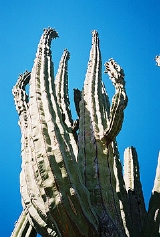
Pachycereus pringlei
Encyclopedia
Pachycereus pringlei is a species of cactus
that is native to northwestern Mexico
in the states of Baja California
, Baja California Sur
, and Sonora
. It is commonly known as Cardón, a name derived from the Spanish word cardo, meaning "thistle."
It is the tallest cactus species in the world, with a maximum recorded height of 19.2 m (63 ft), with a stout trunk up to 1 m (3.3 ft) in diameter bearing several erect branches. In overall appearance, it resembles the related Saguaro
(Carnegiea gigantea), but differs in the fewer ribs on the stems, in being more heavily branched from near to the base of the stem, and in the location of the blossoms.
Large stands of these magnificent cactus still exist, but many have been destroyed as fields have been cleared for cultivation in Sonora.
The fruit of this cactus was an important food for the Seri people in Sonora, who call the cactus xaasj.
The flesh of this cactus contains alkaloid
s, and may have been used as a psychoactive
plant in Mexico
.
A symbiotic
relationship with bacterial and fungal colonies on its roots allows P. pringlei to grow on bare rock even where there is no soil available at all, as the bacteria can fix nitrogen
from the air and break down the rock to produce nutrients. The cactus even packages symbiotic bacteria in with its seeds.
Cactus
A cactus is a member of the plant family Cactaceae. Their distinctive appearance is a result of adaptations to conserve water in dry and/or hot environments. In most species, the stem has evolved to become photosynthetic and succulent, while the leaves have evolved into spines...
that is native to northwestern Mexico
Mexico
The United Mexican States , commonly known as Mexico , is a federal constitutional republic in North America. It is bordered on the north by the United States; on the south and west by the Pacific Ocean; on the southeast by Guatemala, Belize, and the Caribbean Sea; and on the east by the Gulf of...
in the states of Baja California
Baja California
Baja California officially Estado Libre y Soberano de Baja California is one of the 31 states which, with the Federal District, comprise the 32 Federal Entities of Mexico. It is both the northernmost and westernmost state of Mexico. Before becoming a state in 1953, the area was known as the North...
, Baja California Sur
Baja California Sur
Baja California Sur , is one of the 31 states which, with the Federal District, comprise the 32 Federal Entities of Mexico. Before becoming a state on October 8, 1974, the area was known as the South Territory of Baja California. It has an area of , or 3.57% of the land mass of Mexico and comprises...
, and Sonora
Sonora
Sonora officially Estado Libre y Soberano de Sonora is one of the 31 states which, with the Federal District, comprise the 32 Federal Entities of Mexico. It is divided into 72 municipalities; the capital city is Hermosillo....
. It is commonly known as Cardón, a name derived from the Spanish word cardo, meaning "thistle."
It is the tallest cactus species in the world, with a maximum recorded height of 19.2 m (63 ft), with a stout trunk up to 1 m (3.3 ft) in diameter bearing several erect branches. In overall appearance, it resembles the related Saguaro
Saguaro
The saguaro is a large, tree-sized cactus species in the monotypic genus Carnegiea. It is native to the Sonoran Desert in the U.S. state of Arizona, the Mexican state of Sonora, a small part of Baja California in the San Felipe Desert and an extremely small area of California, U.S...
(Carnegiea gigantea), but differs in the fewer ribs on the stems, in being more heavily branched from near to the base of the stem, and in the location of the blossoms.
Large stands of these magnificent cactus still exist, but many have been destroyed as fields have been cleared for cultivation in Sonora.
The fruit of this cactus was an important food for the Seri people in Sonora, who call the cactus xaasj.
The flesh of this cactus contains alkaloid
Alkaloid
Alkaloids are a group of naturally occurring chemical compounds that contain mostly basic nitrogen atoms. This group also includes some related compounds with neutral and even weakly acidic properties. Also some synthetic compounds of similar structure are attributed to alkaloids...
s, and may have been used as a psychoactive
Psychoactive drug
A psychoactive drug, psychopharmaceutical, or psychotropic is a chemical substance that crosses the blood–brain barrier and acts primarily upon the central nervous system where it affects brain function, resulting in changes in perception, mood, consciousness, cognition, and behavior...
plant in Mexico
Mexico
The United Mexican States , commonly known as Mexico , is a federal constitutional republic in North America. It is bordered on the north by the United States; on the south and west by the Pacific Ocean; on the southeast by Guatemala, Belize, and the Caribbean Sea; and on the east by the Gulf of...
.
A symbiotic
Symbiosis
Symbiosis is close and often long-term interaction between different biological species. In 1877 Bennett used the word symbiosis to describe the mutualistic relationship in lichens...
relationship with bacterial and fungal colonies on its roots allows P. pringlei to grow on bare rock even where there is no soil available at all, as the bacteria can fix nitrogen
Nitrogen fixation
Nitrogen fixation is the natural process, either biological or abiotic, by which nitrogen in the atmosphere is converted into ammonia . This process is essential for life because fixed nitrogen is required to biosynthesize the basic building blocks of life, e.g., nucleotides for DNA and RNA and...
from the air and break down the rock to produce nutrients. The cactus even packages symbiotic bacteria in with its seeds.

